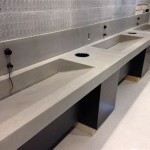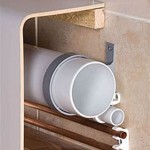How Do You Get Mold Off Of Your Bathroom Walls?
Mold in the bathroom is a common problem, especially in areas with high humidity and moisture. It appears as dark spots, often black or green, and can be a health hazard, especially for people with allergies or respiratory issues. While mold can be unsightly, it's important to address it quickly and effectively to prevent it from spreading and causing further damage to your bathroom. This article will guide you through the process of removing mold from your bathroom walls, providing you with practical tips and safety precautions.
Understanding Mold Growth in Bathrooms
Bathrooms are susceptible to mold growth due to their inherent moisture. Several factors contribute to the problem:
- Showers and Baths: Steam and water droplets from showers and baths create a damp environment.
- Poor Ventilation: Inadequate ventilation allows moisture to linger, providing an ideal breeding ground for mold.
- Leaks: Leaky pipes or faucets can create constant moisture, making mold growth inevitable.
- Condensation: Warm, moist air from showers can condense on cold surfaces like walls, leading to mold growth.
Removing Mold from Bathroom Walls
Removing mold effectively requires a step-by-step approach that tackles both the visible mold and the underlying causes:
1. Preparation and Safety Precautions
- Protect Yourself: Wear a respirator mask, goggles, and rubber gloves to prevent inhaling mold spores and skin irritation.
- Ventilate the Area: Open windows and doors to ensure proper airflow and remove the moist air.
- Isolate the Area: If possible, cover furniture and other surfaces in the bathroom to avoid spreading mold spores.
2. Cleaning the Affected Area
- Scrub with a Solution: Mix a cleaning solution of 1 cup of bleach with 1 gallon of water. Apply the solution to the moldy area using a scrub brush. Allow the solution to sit for 10-15 minutes before scrubbing again.
- Rinse Thoroughly: After scrubbing, rinse the area with clean water to remove any remaining mold and bleach solution.
- Dry the Surface: Dry the cleaned area completely with a towel or fan to prevent re-growth.
3. Addressing Underlying Causes
Cleaning visible mold is only a temporary solution. To prevent re-growth, you must identify and address the root causes:
- Improve Ventilation: Ensure adequate ventilation by using exhaust fans during and after showers. You may need to install a more powerful fan if existing ventilation is insufficient.
- Repair Leaks: Fix any leaks immediately to eliminate a constant source of moisture.
- Control Condensation: Reduce condensation by using a dehumidifier or by installing a fan to circulate air.
- Regular Cleaning: Regularly wipe down bathroom surfaces with a cleaning solution to prevent mold from accumulating.
Preventing Mold Growth
Mold prevention is crucial for maintaining a clean and safe bathroom environment. Here are some preventive measures:
- Dry Surfaces Immediately: After showering or bathing, wipe down wet surfaces, such as shower walls, floors, and mirrors. Ensure these areas dry completely.
- Maintain Adequate Ventilation: Run exhaust fans during and for 30 minutes after showering to remove moisture from the air.
- Clean Regularly: Regularly clean bathroom surfaces with a mold-killing solution. Focus on areas prone to moisture build-up, such as shower corners, grout lines, and around the sink.
- Use a Dehumidifier: If you live in a humid environment, consider using a dehumidifier to reduce moisture levels in the air.
When to Call in Professionals
While most mold problems can be handled with DIY solutions, it is important to know when to seek professional help. If you encounter any of the following, contact a professional mold remediation specialist:
- Extensive Mold Growth: If the mold covers a large area or is embedded deep within the walls, professional remediation is needed.
- Suspected Black Mold: Black mold (Stachybotrys chartarum) can pose significant health risks. If you suspect black mold, consult a professional for safe removal.
- Moisture Source Identification Issues: If you cannot pinpoint the source of the moisture, a professional can help you identify and address the problem.

How To Get Rid Of Mold In Bathroom 2024 Tips From Puroclean

How To Get Rid Of Mold In The Shower On Bathroom Walls Clorox

How To Remove Mold From Walls True Value

How Do You Get Rid Of Mould On Bathroom Walls Igloo Surfaces

Ways To Prevent Mold In Bathrooms Forbes Home

Bathroom Ceiling Mold Removal When To Clean Call Branch Environmental

How To Get Rid Of Mould And Mildew In Your Bathroom Rac Wa

The Ultimate Guide On How To Clean And Get Rid Of Mold Pro Housekeepers

What To Know About Bathroom Mold And When You Should Worry

The Ultimate Guide On How To Clean And Get Rid Of Mold Pro Housekeepers
Related Posts







